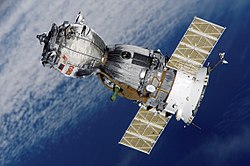| Names | ISS 75S |
|---|---|
| Mission type | ISS crew transport |
| Operator | Roscosmos |
| Mission duration | 240 days (planned) |
| Spacecraft properties | |
| Spacecraft | Soyuz MS-29 No. 759 |
| Spacecraft type | Soyuz MS |
| Manufacturer | Energia |
| Crew | |
| Crew size | 3 |
| Members | |
| Callsign | Tigris [1] |
| Start of mission | |
| Launch date | 14 July 2026 (planned) [2] |
| Rocket | Soyuz-2.1a |
| Launch site | Baikonur, Site 31/6 |
| Contractor | RKTs Progress |
| End of mission | |
| Landing date | March 2027 (planned) [2] |
| Landing site | Kazakh Steppe, Kazakhstan |
| Orbital parameters | |
| Reference system | Geocentric orbit |
| Regime | Low Earth orbit |
| Inclination | 51.66° |
| Docking with ISS | |
| Docking port | Prichal nadir |
| Docking date | 14 July 2026 (planned) |
| Undocking date | March 2027 (planned) |
 From left: Menon, Dubrov and Kikina | |
Soyuz MS-29 is a planned Russian crewed Soyuz spaceflight to launch from Baikonur on 14 July 2026 to the International Space Station.

